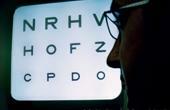Vision check

When the doctor finds out the information necessary for him about the health of your family, he will proceed to the next stage. Most likely, he will ask you to name letters or numbers, which he will indicate in the table, consisting of rows arranged and gradually decreasing in the size of letters and numbers. It allows you to determine the severity of central vision. If you wear contact lenses, vision will be checked at the moment. In addition, using a special tool called a lensometer, the doctor will check your glasses to confirm whether the diagnosis was correctly made.
Evaluation will be made in comparison with a person who has normal vision. If the result shows 20/20, it means that at a distance of twenty steps you see as well as a person with normal vision. However, if the score is 20/40, it means that a healthy person sees at a distance of forty steps what you see at a distance of twenty. In other words, in order to clearly see the object, you need to approach it. The general rule is this: the higher the second number, the worse your eyesight. This rule applies to everyone, regardless of whether you have short-sightedness or farsightedness.
If the test on the table shows that you need to pick up a prescription or prescribe contact lenses, the doctor measures a refraction or eye refraction violation using tools that contain a set of contact lenses of different strengths. To confirm the testimony and find out what provide the best vision, you will be given to test the lens of varying strength.
Your peripheral vision will also be inspected. The usual procedure is this: you will be asked to close one eye, and others to look at the point directly in front of you. The doctor will move the object, for example the pen, forward, back and side of your field of vision, and ask you to tell when it will start moving. If additional testing is required, tools can help you identify the possibilities of your peripheral vision.
Thus, regular examination is the best way to protect against eye diseases associated with the aging process.
If any violations were found during the examination, it is necessary to understand what the diagnosis and treatment are, by asking the doctor urgent questions, for example, what tests do you need to do to confirm the diagnosis?
Preservation of vision is a work based on mutual cooperation between the patient and the doctor. Do not hesitate to ask questions to clarify something that you do not understand.
Yu. Saveleva "Methods of vision improvement"
